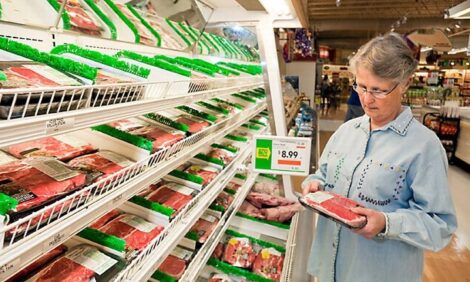



Pork Commentary: Deluge of Hogs Continue
CANADA - If it seems to you that it’s raining hogs, join the crowd. We feel the same way, writes Jim Long. Relentless numbers of hogs continue to come to market with last week’s USDA calculation of 2.117 million head, a whopping 162,000 more than the same week a year ago.It is now three weeks in a row that US marketings have exceeded 2.1 million. We believe that there is no way that these types of weekly marketings can continue. Despite these large numbers, the lean hog price is holding together with Friday’s Iowa-Minnesota 57.68 lean.
Lets face it, we better get hog numbers down fast or May’s lean hog future close of 73.27 last Friday will only be a dream. May lean futures are around $30.00 per head higher than Friday’s Iowa-Minnesota average.
This Friday, the USDA March Hogs and Pigs Report will be released. As the most accurate indicator of swine inventory, it should give a better understanding and explanation for the huge marketings over the last three weeks. Also this week, the USDA will come out with projected planting intentions. Everyone knows that there will be significantly more corn planted in 2007 - the billion dollar question, “How much?” All we know is that $4.00 corn is going to get more corn planted in the US and the rest of the world.
USDA Cold Storage Report
There was significantly less chicken and pork in storage at the beginning of March
|
March 1st 2007
(Thousand pounds) |
||
| 2006 | 2007 | |
|---|---|---|
| Chicken | 923 | 626 |
| Beef | 440 | 451 |
| Pork | 528 | 483 |
| Total | 1891 | 1560 |
Less meat in storage is positive for hog prices, as slaughter numbers seasonally decline. Chicken, which is probably pork’s biggest price point competitor, has a lot less product in storage than a year ago.
|
Bellies in Storage
(Thousand pounds) |
|
| 2006 | 2007 |
|---|---|
| 58,861 | 46,090 |
Animal Welfare
The Menu Foods pet food problem makes you wonder about society’s take on proportion. We know that if you have a pet, it is an important part of a family. When they are sick and dying from what appears tainted pet food, it is a tragedy. When we read that it is the most Googled issue in North America last week, it makes us take a pause. Tens of billions are spent on pets in North America a year. The issue we see is the fringe of the Animal Welfare world, such as the Humane Society of the United States and PETA, are successfully capturing the essence of pet humanization and coming at us in the food industry. We lose in the Menu Foods issue, as almost every politician and their tin ears can see the concern that a significant amount of society have for pets and, with possible extension, all livestock.
We are even losing at our agriculture schools. The University of Guelph, which many would argue is (maybe was) the preeminent Canadian Agricultural University, last week banned the usage of eggs from chickens in cages in its food service. If agriculture schools are being taken over by society’s value police, where does it end? As a life science company that invests in research at the University of Guelph, it makes us wonder, do we continue to fund science and research at a university that bases decisions on political correctness rather than legal means of production? What’s next, University of Guelph foodservice only selling pork from pen gestation, antibiotic free, 35 day weaning, outside, etc? Legal food being banned by an agriculture university? When do we say enough is enough and tie funding to ethical treatment of farmers? The University of Guelph should be ashamed of itself.
All life science, marketing boards, government funding to the University of Guelph should be tied to a continued use of legal food by its foodservice. It’s our industry, it’s our right and we need to protect it.
Other Observations
- US sow slaughter was about 5% higher the first two months this year, compared to last. We have a hard time believing that there is any significant expansion.
- Canadian small pig exports to the US continue to grow. Year-to-date about 10,000 more a week, compared to last year. This trend, we expect to continue. The migration of pigs to where there are the highest number of slaughter plants and the area of best manure utilization is inevitable.
- Have we seen a paradigm shift in prices? There were three major shifts in agriculture prices in the last century; 1914-15, 1942-43, 1972-73, every thirty years. This is when we established new price lists for ag-commodities including hogs. Are we now at a new price threshold? The answer is probably yes. With hog building costs where they are, even a collapse of the grain market would keep cost of production of lean hogs north of 60¢ lean. All costs; labour, energy, feed, tractors, combines, land, etc are such that there would be no long-term or even short-term sustainability for low prices. We are probably entering a new three decade price level of higher prices and higher costs. Not necessarily one of higher profits, but maybe. We hope.









